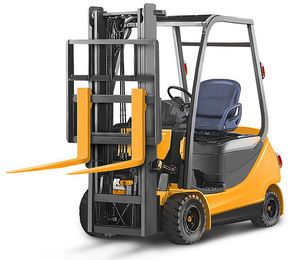Selecting the Right Forklift Tire: Pneumatic or Cushion?
Choosing the right type of forklift tire is the best way to ensure safe handling and high performance. When it comes to purchasing forklifts or replacement tires, however, buyers are often met with two tire options: pneumatic and cushion. While some forklift models can take both, there are major differences between the two that need to be considered during the buying process.

Here's a short overview of each type, followed by a side-by-side comparison of their individual pros and cons.
Pneumatic tires
Pneumatic tires are the most commonly found variety on forklifts and also offer the greatest performance and versatility. Like the tires on most automobiles, pneumatic tires are filled with air, allowing them to grip uneven surfaces and rough terrain. As a result, pneumatic tires are not only popular for warehouses, but can also be found on rough terrain forklifts used in construction sites and lumber yards.
Cushion tires
Unlike air-filled pneumatic tires, cushion tires are made of solid rubber. Although this makes them cheaper to manufacture and easier to maintain than pneumatic tires, it comes at a loss of traction and decreased performance and efficiency. However, there are still other benefits associated with cushion tires that make them a favorite in warehouse environments.
Other forklift tire considerations
Although some models take either type of forklift tire, most usually require one or the other for many reasons, apart from handling and frame design. For example, rough terrain forklifts almost always use pneumatic tires since they allow for better handling and traction on difficult terrain and uneven surfaces. However, there are occasional exceptions; in this case, there is a type of cushion tire used for rough terrain forklifts known as solid rubber tires, which are used in rough environments where sharp debris could easily pop an air-filled tire.
Outside of basic handling and performance, be sure to consider space constraints. Warehouses, for example, often have small spaces that require the use of a tire with a smaller turning radius. For this application, cushion tires would be ideal. On the other hand, pneumatic tires are ideal for outdoor spaces with greater turning freedom and special handling requirements.
Side-by-side comparison: pneumatic tires vs. cushion tires
| Pros | Cons | ||
Pneumatic Tire |
Cushion Tire |
Pneumatic Tire |
Cushion Tire |
| High performance | Easy to maintain (no need to inflate, etc.) | More expensive than cushion tires | Less efficient |
| High efficiency | Durable | Can be difficult to replace | Decreased performance |
| Able to operate on rough terrain and uneven surfaces | Cannot pop on rough surfaces | Requires regular maintenance and upkeep (inflation, etc.) | Less traction and handling abilities |
| Greater traction and handling | Cheaper than pneumatic tires | Larger turning radius | |
| Smaller turning radius | |||